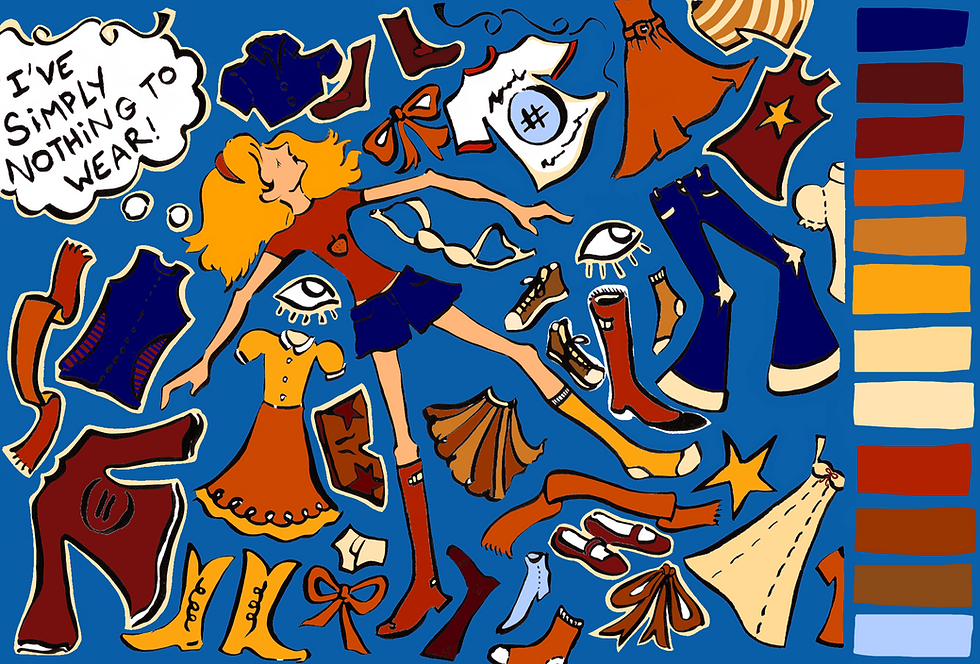
Fall is finally here: leaves are turning from green to gold, Christian girl autumn posts are beginning to adorn once bikini-covered Instagrams, and glasses of lemonade are being replaced by steaming pumpkin spice lattes. In recent years, hundreds of ads, articles, posts and videos focused on the “Must-Have Trends” have joined the crisp crunch of a dried leaf underfoot as a classic part of fall.
To be clear, fashion trends aren’t new, nor is widespread coverage of them. Fashion magazines like Vogue and Harper’s Bazaar have been reporting on rising trends and advising readers on popular styles for decades. However, the landscape of this world is completely different in the digital age than it was a mere fifteen years prior. Most notably, social media and the internet have made the spread of ideas nearly instantaneous. In some ways, this has been incredibly positive: the democratization of information means marginalized creators and niche content are able to gain prominence. Everyone has a voice. However, when everyone has a voice, it takes more to be heard; larger influencers can present a level of consistent consumption completely unattainable to the average consumer, considering they are often gifted free products in exchange for promotion. Additionally, the increasing instability of the political and economic state of the world has pushed many people online and encouraged them to seek comfort in the pursuit of beauty. For many, these behaviors are a somewhat fruitless attempt to gain a sense of control.
This leads to some of the more detrimental elements of style and clothing content in the social media age. In order to gain views and notoriety in an algorithm-driven landscape, it’s not enough to simply be a stylish person. There’s pressure to follow every trend for engagement. Small and large creators alike film huge hauls in order to create popular content and have clothes for new outfits every day. Often, in order to keep the prices of these purchases relatively low, influencers shop from fast-fashion brands like Shein. Now, simply being a person who wears their clothes and uses the products they own is “so underconsumption core.”
In such a heavily consumerist culture, identity is not about who you are or what you do, it’s about how you look and what you own. For those who feel lost in a complex, demoralizing world, a concrete sense of identity achieved through purchases rather than introspection and a momentary sense of peace that doesn’t rely on systemic change is appealing. It’s deeply lonely to be depressed, but it’s romantic to be a Lana Del Rey, smeared red lipstick, cigarette sad girl. It’s scary to confront the reality of climate change and ever-depleting natural resources, but it’s thrilling to imagine a cottagecore fantasy where the land is beautiful, the bounty plentiful and every garment is airy and floral. All of these desires are perfectly natural; it’s a logical instinct to seek control in a world where the majority of the populus is often deprived of that autonomy. However, no systemic or personal problems can truly be solved via a well-crafted label or perfectly curated outfit. The pursuit of identity through aestheticism is futile and the consumption necessary to satiate that hunger only exacerbates existing issues.
In some ways, this seems like a non-issue. Not everyone encounters fashion content or obsesses over aesthetics. It’s mostly relevant to chronically-online fashionista girlitas. Nevertheless, many organizations have reported a rise in fast fashion and rapid consumption due to the social media landscape. The speed at which information is shared, products are produced, bought, worn, posted and popularized has made the trend cycle faster than ever before, leading to more consumption, and by extension, more waste. The fashion industry contributes nearly 10% of all carbon emissions, plastic fibers from clothes pollute waterways, clothes fill landfills, and their production is the second biggest consumer of water.
Aside from the sustainability component, many clothing companies exploit workers to keep costs low and profit margins high. The majority of fast fashion is produced in the global south, where safety regulations are disregarded, pay is low, and workers are frequently put in danger. This subjugation is furthered by the demographics of garment workers: primarily women of color, who often face abuse in the workplace, but lack the resources and financial stability to advocate for themselves.
While confronting the multitude of problems that make the world feel so hopeless is a steep task for any academic, activist or political leader, let alone an article originally intended to focus on knee-high boots and infinity scarves, one message is undeniable. Overconsumption needs to stop. This doesn’t mean shopping needs to stop or that an interest in following trends is vapid or immoral, it merely means sustainable options should be prioritized. For example, the rapid turn around of trends means trendy pieces often end up in thrift stores while the style is still popular, making them a great place to affordably experiment with fads. Additionally, online thrifting sites are becoming more popular and easier to search, allowing for the casual scroll and ease of use that make traditional online shopping so appealing. For those looking to spend no money at all, clothing swaps are an easy way to get new pieces without creating any waste. Or … boldly, radically, bravely, people can just wear the clothes they already own. By rewearing an old piece of clothing in a different way or pairing items together that would normally be kept separate, it’s easy to breathe new life into old clothes.
In a world where the impacts of climate change become more present by the year, buying less and living more sustainably is the only truly timeless trend.

Kommentare